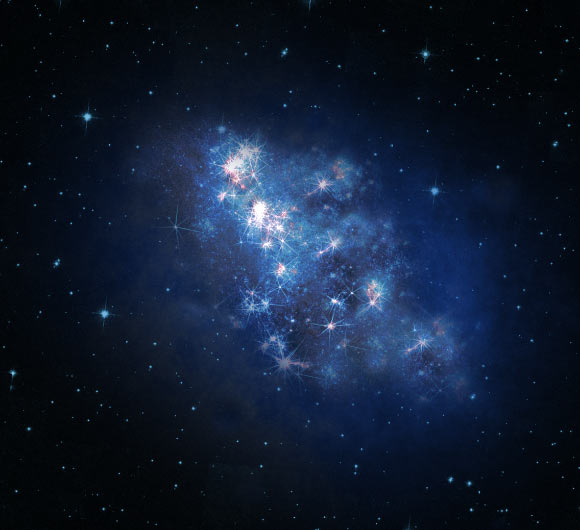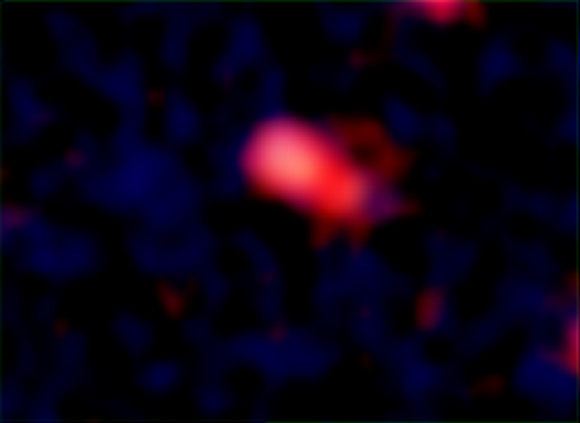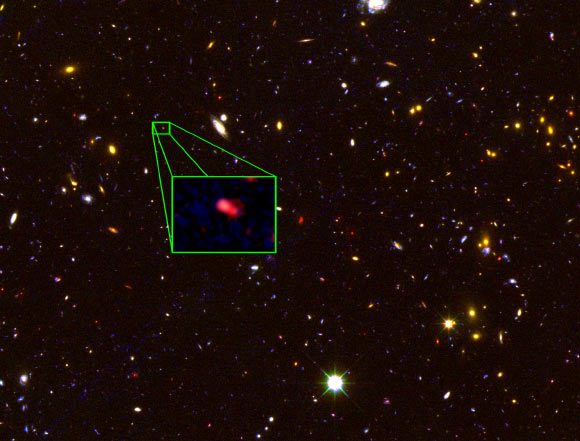Astronomers led by Dr Steven Willner from Harvard-Smithsonian Center for Astrophysics have discovered what they believe is the most distant galaxy ever found.

This is an artist’s impression of the galaxy Z8-GND-5296. Image credit: V. Tilvi / S.L. Finkelstein / C. Papovich / the Hubble Heritage Team.
The galaxy, labeled Z8-GND-5296, is seen as it was just 700 million years after the Big Bang.
“Because of its distance we get a glimpse of conditions when the Universe was only about 700 million years old – only 5 percent of its current age of 13.8 billion years,” said Dr Casey Papovich from Texas A&M University, who is the second author of a paper appearing in the journal Nature.
Because the Universe has been expanding the whole time, the researchers estimate the galaxy’s present distance to be roughly 30 billion light years away.
Astronomers are able to accurately gauge the distances of galaxies by measuring a feature from the ubiquitous element hydrogen called the Lyman alpha transition, which emits brightly in distant galaxies. It’s detected in nearly all galaxies that are seen from a time more than one billion years from the Big Bang, but getting closer than that, the hydrogen emission line, for some reason, becomes increasingly difficult to see.

This Hubble image shows Z8-GND-5296, the most distant galaxy in the Universe. Image credit: V. Tilvi / S.L. Finkelstein / C. Papovich / A. Koekemoer / CANDELS / STScI / NASA.
“What makes this galaxy unique, compared to other such discoveries, is the spectroscopic confirmation of its distance,” said co-author Prof Bahram Mobasher from the University of California.
The discovery of Z8-GND-5296 was made possible by a new instrument, Multi-Object Spectrometer for Infra-Red Exploration (MOSFIRE), at the W.M. Keck Observatory in Hawaii. Not only is MOSFIRE extremely sensitive, but it is designed to detect infrared light and could target multiple objects at a time. It was the latter feature that allowed the team to observe 43 galaxy candidates in only two nights, and obtain higher quality observations than previous studies.
Of the 43 galaxies observed with the instrument, the team detected Lyman alpha feature from only one galaxy – Z8-GND-5296. The astronomers suspect they may have zeroed in on the era when the Universe made its transition from an opaque state in which most of the hydrogen is neutral to a translucent state in which most of the hydrogen is ionized – co-called the Era of Re-ionization.
Z8-GND-5296 is forming stars extremely rapidly – producing each year about 300 times the mass of our Sun. By comparison, our Milky Way Galaxy forms only 2 – 3 stars per year.

This Hubble image shows the galaxy Z8-GND-5296. The galaxy’s red color alerted astronomers that it was likely extremely far away, and thus seen at an early time after the Big Bang. Image credit: V. Tilvi / S.L. Finkelstein / C. Papovich / A. Koekemoer / CANDELS / STScI / NASA.
“By observing a galaxy that far back in time, we can study the earliest formation of galaxies,” Prof Mobasher said.
“By comparing properties of galaxies at different distances, we can explore the evolution of galaxies throughout the age of the Universe.”
______
Bibliographic information: Finkelstein SL et al. 2013. A galaxy rapidly forming stars 700 million years after the Big Bang at redshift 7.51. Nature 502, pp. 524–527; doi: 10.1038/nature12657







